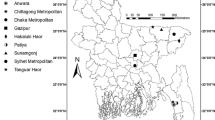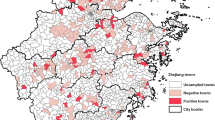Abstract
Migratory birds have been known to spread the highly pathogenic avian influenza virus (HPAIV) H5N1 over large distances. Moreover, previous studies have shown it to be widely circulated in live-bird markets. However, how live-bird markets in addition to wild birds affect the local persistence of avian influenza virus (AIV) remains uncertain. The abundance of fresh water and widely distributed wetlands make the Poyang lake area a suitable overwintering site for migratory birds. The intensive local poultry industry and poor biosecurity potentially increase the risk of interactions between the wild and domestic birds. These factors likely contributed to the spread and persistence of AIVs in the Poyang lake area in these years. Here, a cross-sectional survey together with sampling was conducted randomly in the Poyang lake area to investigate the local distribution of the H5N1 viruses. In total, 891 poultry isolates from 31 villages around the Poyang lake area were randomly sampled in poultry sectors and tested for the presence of avian influenza using RT-PCR assays. Environmental factors such as poultry density, road accessibility, and wild bird biodiversity together with breeding characteristics derived from these questionnaires were collected and utilized for risk analysis modelling. Our results revealed that distance to the nearest wetlands with a high number of birds and accessibility by road were the main risk factors for the occurrence HPAIV H5N1, suggesting that the high density of road networks may facilitate the transmission of this virus. Investigating the regional distribution characteristics of the virus is of great significance, therefore the general public would benefit from an early warning, prevention, and taking control measures in high-risk regions.

Similar content being viewed by others
References
Cappelle J, Zhao D, Gilbert M, Nelson MI, Newman SH, Takekawa JY, Gaidet N, Prosser DJ, Liu Y, Li P, Shu Y, Xiao X (2014) Risks of avian influenza transmission in areas of intensive free-ranging duck production with wild waterfowl. EcoHealth 11:109–119
Chen H, Smith GJ, Li KS, Wang J, Fan XH, Rayner JM, Vijaykrishna D, Zhang JX, Zhang LJ, Guo CT, Cheung CL, Xu KM, Duan L, Huang K, Qin K, Leung YH, Wu WL, Lu HR, Chen Y, Xia NS, Naipospos TS, Yuen KY, Hassan SS, Bahri S, Nguyen TD, Webster RG, Peiris JS, Guan Y (2006) Establishment of multiple sublineages of H5N1 influenza virus in Asia: implications for pandemic control. Proc Natl Acad Sci USA 103:2845–2850
Fang L, de Vlas S, Liang S, Looman C, Gong P, Xu B, Yan L, Yang H, Richardus J, Cao W (2008) Environmental factors contributing to the spread of H5N1 avian influenza in mainland China. PLoS ONE 3:e2268
Fournié G, Guitian J, Desvaux S, Cuong V, Pfeiffer D, Mangtani P, Ghani A (2013) Interventions for avian influenza A (H5N1) risk management in live bird market networks. Proc Natl Acad Sci USA 110:9177–9182
Hastie TJ, Tibshirani RJ (1990) Generalized additive models, vol 43. CRC Press, Boca Raton
Horimoto T, Kawaoka Y (2001) Pandemic threat posed by avian influenza A viruses. Clin Microbiol Rev 14:129–149
Hulse-Post DJ, Sturm-Ramirez KM, Humberd J, Seiler P, Govorkova EA, Krauss S, Scholtissek C, Puthavathana P, Buranathai C, Nguyen TD, Long HT, Naipospos TS, Chen H, Ellis TM, Guan Y, Peiris JS, Webster RG (2005) Role of domestic ducks in the propagation and biological evolution of highly pathogenic H5N1 influenza viruses in Asia. Proc Natl Acad Sci USA 102:10682–10687
Ji W, Zeng N, Wang Y, Gong P, Xu B, Bao S (2007) Analysis on the waterbirds community survey of Poyang lake in winter. Geog Inf Sci 13:51–64
Li C, Hatta M, Nidom CA, Muramoto Y, Watanabe S, Neumann G, Kawaoka Y (2010) Reassortment between avian H5N1 and human H3N2 influenza viruses creates hybrid viruses with substantial virulence. Proc Natl Acad Sci USA 107:4687–4692
Lockhart C, Stevenson M, Rawdon T, Gerber N, French N (2010) Patterns of contact within the New Zealand poultry industry. Prev Vet Med 95:258–266
Martin V, Zhou X, Marshall E, Jia B, Fusheng G, FrancoDixon MA, DeHaan N, Pfeiffer DU, Soares Magalhaes RJ, Gilbert M (2011) Risk-based surveillance for avian influenza control along poultry market chains in South China: the value of social network analysis. Prev Vet Med 102:196–205
Mukhtar MM, Rasool ST, Song D, Zhu C, Hao Q, Zhu Y, Wu J (2007) Origin of highly pathogenic H5N1 avian influenza virus in China and genetic characterization of donor and recipient viruses. J Gen Virol 88:3094–3099
Olsen B, Munster VJ, Wallensten A, Waldenstrom J, Osterhaus AD, Fouchier RA (2006) Global patterns of influenza a virus in wild birds. Science 312:384–388
Pandit PS, Bunn DA, Pande SA, Aly SS (2013) Modeling highly pathogenic avian influenza transmission in wild birds and poultry in West Bengal. India Sci Rep 3:2175
Smith G, Fan XH, Wang J, Li K, Qin K, Zhang J, Vijaykrishna D, Cheung C, Huang K, Rayner J (2006) Emergence and predominance of an H5N1 influenza variant in China. Proc Natl Acad Sci USA 103:16936–16941
Soares Magalhães R, Zhou X, Jia B, Guo F, Pfeiffer D, Martin V (2012) Live poultry trade in Southern China provinces and HPAIV H5N1 infection in humans and poultry: the role of Chinese new year festivities. PLoS ONE 7:e49712
Stallknecht DE, Shane SM (1988) Host range of avian influenza virus in free-living birds. Vet Res Commun 12:125–141
Su B, Wurtzer S, Rameix-Welti MA, Dwyer D, van der Werf S, Naffakh N, Clavel F, Labrosse B (2009) Enhancement of the influenza A hemagglutinin (HA)-mediated cell-cell fusion and virus entry by the viral neuraminidase (NA). PLoS ONE 4:e8495
Tian H, Xu B (2015a) Anthropogenic factors and societal response to challenges in the transmission of highly pathogenic avian influenza A (H5N1). Ann GIS 21:1–8
Tian H, Xu B (2015b) Persistence and transmission of avian influenza A (H5N1): virus movement, risk factors and pandemic potential. Ann GIS 21:55–68
Tian H, Cui Y, Dong L, Zhou S, Li X, Huang S, Yang R, Xu B (2015a) Spatial, temporal and genetic dynamics of highly pathogenic avian influenza A (H5N1) virus in China. BMC Infect Dis 15:54
Tian H, Zhou S, Dong L, Van Boeckel TP, Cui Y, Wu Y, Cazelles B, Huang S, Yang R, Grenfell BT (2015b) Avian influenza H5N1 viral and bird migration networks in Asia. Proc Natl Acad Sci USA 112:172–177
Tian H, Zhou S, Dong L, Van Boeckel TP, Pei Y, Wu Q, Yuan W, Guo Y, Huang S, Chen W (2015c) Climate change suggests a shift of H5N1 risk in migratory birds. Ecol Modell 306:6–15
Van Kerkhove MD, Vong S, Guitian J, Holl D, Mangtani P, San S, Ghani AC (2009) Poultry movement networks in Cambodia: implications for surveillance and control of highly pathogenic avian influenza (HPAI/H5N1). Vaccine 27:6345–6352
Wang Y, Jiang Z, Jin Z, Tan H, Xu B (2013) Risk factors for infectious diseases in backyard poultry farms in the Poyang lake area China. PLoS ONE 8:e67366
Wang G, Zhang T, Li X, Jiang Z, Jiang Q, Chen Q, Tu X, Chen Z, Chang J, Li L (2014) Serological evidence of H7, H5 and H9 avian influenza virus co-infection among herons in a city park in Jiangxi China. Sci Rep 4:6345
Webster RG (2004) Wet markets—a continuing source of severe acute respiratory syndrome and influenza? Lancet 363:234–236
Webster RG, Yakhno M, Hinshaw VS, Bean WJ, Murti KG (1978) Intestinal influenza: replication and characterization of influenza viruses in ducks. Virology 84:268–278
Webster RG, Bean WJ, Gorman OT, Chambers TM, Kawaoka Y (1992) Evolution and ecology of influenza A viruses. Microbiol Rev 56:152–179
WHO (2011) Cumulative number of confirmed human cases for avian influenza A(H5N1) reported to WHO, 2003–2011
Wu X, Lv M, Jin Z, Michishita R, Chen J, Tian H, Tu X, Zhao H, Niu Z, Chen X (2014) Normalized difference vegetation index dynamic and spatiotemporal distribution of migratory birds in the Poyang Lake wetland, China. Ecol Indic 47:219–230
Yupiana Y, de Vlas SJ, Adnan NM, Richardus JH (2010) Risk factors of poultry outbreaks and human cases of H5N1 avian influenza virus infection in West Java Province, Indonesia. Int J Infect Dis 14:e800–e805
Zhang T, Bi Y, Tian H, Li X, Liu D, Wu Y, Jin T, Wang Y, Chen Q, Chen Z (2014) Human infection with influenza virus A (H10N8) from live poultry markets China 2014. Emerg Infect Dis 20:2076
Acknowledgments
This research was supported by the Ministry of Science and Technology, China, National Research Program (2012CB955501, 2012AA12A407), the National Natural Science Foundation of China (41271099), the Fundamental Research Funds for the Central Universities (2013YB46), the Open Fund of State Key Laboratory of Remote Sensing Science (OFSLRSS201311), and the Poyang National Nature Reserve. The funders had no role in study design, data collection and analysis, decision to publish, or preparation of the manuscript.
Author information
Authors and Affiliations
Corresponding author
Ethics declarations
Conflict of interest
The authors declare no conflicts of interest.
Additional information
“This article is a part of a Topical Collection in Environmental Earth Sciences on “Environment and Health in China II”, guest edited by Tian-Xiang Yue, Cui Chen, Bing Xu and Olaf Kolditz”.
Rights and permissions
About this article
Cite this article
Huang, S., Tian, H., Wu, X. et al. Risk analysis of H5N1 highly pathogenic avian influenza in poultry at the Poyang Lake area, China. Environ Earth Sci 75, 955 (2016). https://doi.org/10.1007/s12665-015-5111-2
Received:
Accepted:
Published:
DOI: https://doi.org/10.1007/s12665-015-5111-2




